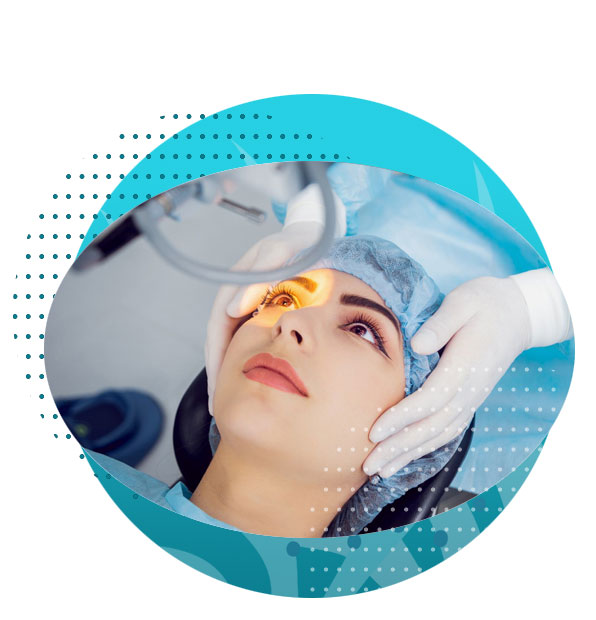Cataract
The human lens, what is its role?
The human lens is located in the middle compartment of the eye. It provides about one-third of the focusing power of the eye and all of the variable component of the focusing power.
What is Presbyopia?
In a young eye, the muscles and ligaments around the lens allow it to dynamically change its shape for close focus. In middle age, the lens becomes stiff and less able to change shape. Reading then becomes more difficult. This is known as presbyopia.
What is a cataract?
Further aging results in decreased clarity of the human lens. The word ‘cataract’ comes from the Greek word for a ‘waterfall’ describing the appearance of the affected lens.
What causes cataract?
Apart from aging, certain medical conditions, such as diabetes, certain medications, especially steroids and radiation, can give rise to cataract. It may occur in both eyes together or there can be asymmetry with the involvement of one eye at a time.
What are the symptoms of cataract?
Initially, the cataract can be mild and have only a subtle effect on vision.
As the lens develops increasing opacity, the vision can be indistinct and faded and there can be glare sensitivity. Sometimes reading vision can improve, but this can mean that the cataract is progressing.
What is the aim of cataract surgery?
The purpose and benefit of cataract surgery is to remove the substance of the ‘cloudy’ lens and replace it with a new artificial lens. This restores the clarity of vision and focusing power of the eye.


Dominant Eye
Most of us favour one eye for certain tasks, such as to looking through a camera view finder or lining up a target, say in snooker. Very often, planning cataract surgery we will choose the dominant eye to be corrected for distance and the non-dominant ‘fellow’ eye for intermediate or near.
Frequently asked questions regarding cataract surgery
- What tests will be done prior to the surgery?
- What issues will be discussed prior to surgery?
- Will I still need glasses after the operation?
- Can astigmatism be corrected at the time of cataract surgery?
A full ocular examination is carried out to ascertain the potential vision of the eyes. In particular, conditions such as dry eyes, glaucoma and macular disease need to be detected and managed prior to the operation. Scans and measurements of various parts of the eye are made and calculations are carried out to determine the power and type of lens to be used.
The risks and benefits of the operation for each patient will be discussed. We will ask about your general health and usual medications. We will discuss your visual needs and refractive planning, that is the choice or intra-ocular lens and types and power.
Insertion of the new lens gives the surgeon the opportunity to correct refractive errors that were present prior to the surgery. There is currently no artificial lens which can vary its focus from far to near.
The standard type of artificial lens has a fixed focus, in which case glasses are often needed to adjust the focus for different distances, typically for reading.
The need for glasses can be lessened by using different focal powers for the two eyes or by the use of multifocal intraocular lenses.
Each strategy has advantages and disadvantages. We will discuss this with you prior to the surgery.
The following is a more detailed guide, but we will guide you through the decision process at the pre-op consultation.
Part of the examination involves measurement of astigmatism. A small degree of astigmatism is part of the normal state of an eye and can be left uncorrected.
Refractive Planning of Cataract Surgery
This is a brief overview. However, it is important to note that each case is different. We take a look at the pros and cons of the different options.
Reference.
- 1. Both eyes corrected for distance
- 2. One eye corrected for distance and one eye for near (monovision)
- 3. One eye for distance and one for intermediate vision (mini-monovision)
- 4. Both eyes for near
- 5. Extended depth of field lenses
- 6. Multifocal Intra-Ocular Lenses
Pros
- Very sharp distance vision without glasses
- Good binocular balance
- Very sharp vision with multifocal glasses
- Very sharp reading vision with reading glasses
- Good driving vision without glasses
Cons
- Poorer depth perception without glasses
- Able to see the exit signs in the supermarket, but not the labels on groceries without glasses
- May have difficulty seeing dashboard display while driving even though distance vision is good
Pros
- Typically, the patient has good general-purpose vision without glasses
- Good distance and reading vision (general-purpose vision) in many patients without glasses. About 30% of patients do not use glasses often.
- Glasses still give excellent, very sharp all-round vision
- No glare and haloes at night
Cons
- Not very good depth perception without glasses
- Really need distance and reading glasses or multifocal glasses for best clarity and binocular depth perception
Pros
- good distance and intermediate vision without glasses
- the imbalance between the eyes is better tolerated
- good ‘supermarket’ vision
- good general-purpose vision without glasses
- good option for nursing home patients
Cons
- Reading glasses may still be needed
Pros
- Best near vision for people who read a lot who want to be spectacle free for reading
- Excellent near depth perception
- Good option for patients with a convergent squint
- Excellent binocular distant vision when using glasses
- No glare or halos at night if glasses are worn to drive
Cons
- Need glasses for distance
Pros
- Excellent distant and intermediate vision without glasses
- Minimal glare and haloes at night
- Excellent depth perception
Cons
- Reading glasses often still needed
- Slightly more expensive than conventional intraocular lenses
Pros
- The best chance of spectacle independence, although spectacles can sometimes be needed to refine the vision
- Best binocular depth perception
- Very good overall vision
- Well tolerated with modern lens designs
- Best results if implanted binocularly
- A good option for nursing home patients
Cons
- More likely to give glare and haloes at night, although these are more often an observation than interfering with vision
- In some patients, glasses may be needed part-time
- Occasionally, there may be a need for a second procedure to achieve independence from glasses
- The lenses are more expensive, although this is offset to an extent by the decreased need for spectacle
- Not currently accepted in Australia by CASA, although many overseas pilots overseas have multifocal intraocular lenses and fly without difficulties
We pride ourselves in high level of patient care, aiming to provide each patient with individualised attention from your first consultation and well beyond your eye surgery recovery.
WORKING HOURS
ASHFIELD EYE CLINIC
Located conveniently in the centre of Ashfield (opposite the Holden Street entrance to Ashfield Mall), the clinic is only 5 minutes from the train station.
Ground Floor, 2 Holden St
Ashfield, Sydney, NSW 2131



